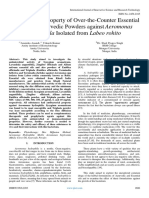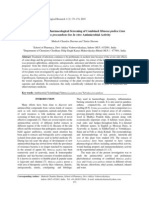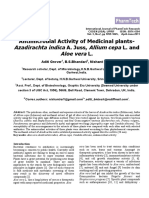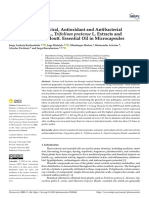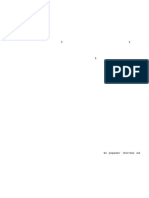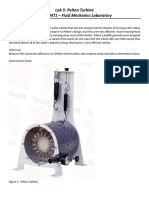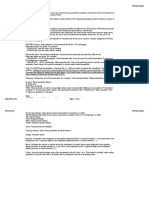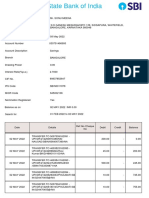Pharmacological Activities of Essential Oil Extracted From Viola Patrinii Against Some Gram Positive and Gram Negative Bacteria As Well Fungal Strains
Pharmacological Activities of Essential Oil Extracted From Viola Patrinii Against Some Gram Positive and Gram Negative Bacteria As Well Fungal Strains
Copyright:
Available Formats
Pharmacological Activities of Essential Oil Extracted From Viola Patrinii Against Some Gram Positive and Gram Negative Bacteria As Well Fungal Strains
Pharmacological Activities of Essential Oil Extracted From Viola Patrinii Against Some Gram Positive and Gram Negative Bacteria As Well Fungal Strains
Original Title
Copyright
Available Formats
Share this document
Did you find this document useful?
Is this content inappropriate?
Copyright:
Available Formats
Pharmacological Activities of Essential Oil Extracted From Viola Patrinii Against Some Gram Positive and Gram Negative Bacteria As Well Fungal Strains
Pharmacological Activities of Essential Oil Extracted From Viola Patrinii Against Some Gram Positive and Gram Negative Bacteria As Well Fungal Strains
Copyright:
Available Formats
Volume 6, Issue 6, June – 2021 International Journal of Innovative Science and Research Technology
ISSN No:-2456-2165
Pharmacological Activities of Essential Oil Extracted
from Viola patrinii against Some Gram Positive and
Gram Negative Bacteria as Well Fungal Strains
Sajad Yousuf1, Tahira Yousuf2, Chhaya Deshmukh*1, R.K. Bachheti3
1
Department of Biochemistry, Maharishi University of Information Technology, Lucknow, India
2
Department of Immunology & Molecular Medicine, SKIMS, J&K, India
3
College of Natural and Computational Science, Haramaya University Ethiopia
*Corresponding Authors:
Dr. Chhaya Deshmukh Sajad Yousuf
Departmentof Biochemistry Department of Biochemistry
Maharishi University of Information Technology Maharishi University of Information Technology
Lucknow (UP), India Lucknow (UP), India
Abstract:- The rapid alarming drug resistance against I. INTRODUCTION
pathogenic microorganisms is a medical catastrophe for
the world. The possible deferring force is to concise the The mixture of terpenoids makes essential oil that is
use of antimicrobials synthesised at industrial level and obtained from aromatic and medicinal plants. The phytotype
investigate for natural medicinal plant derived composition present in the essential oil is specific for a
compounds having properties of fighting specific plant species [1]. Plants and plant derived
microorganisms. In this regard, the aim of this study was compounds have played essential roles for the synthesis of
to find the antimicrobial properties of Essential oil new pharmaceutical products and many known drugs. From
obtained from Viola patrinii. The essential oil of Viola that time higher plants have become main source for the
patrinii showed lowest inhibition zone about 6.62 mm discovery of many drugs and among the discovered drugs a
against S.aureus at the concentration of 250 μg/ml and handful of 100 drugs with well known structure are
showed highest zone of inhibition about 16.37 mm commonly used [2]. The great number of chemicals have
against E.coli at the concentration of 1000 μg/ml for been derived from plants as medicine by scientific
bacterial strains. The essential oil of Viola patrinii evaluation, and these plants are used traditionally for the
showed lowest inhibition zone about 8.02 mm against treatment of bacterial infection and hence exploiting the
A.niger at the concentration of 250 μg/ml and showed power of plant derived compounds for the discovery of anti-
highest zone of inhibition about 15.23 mm against microbials with a great therapeutic potential [3].
C.albicans at the concentration of 1000 μg/ml for fungal
strains. The essential oil Viola patriii showed high Medicinal plants are to be screened from recent years
antimicrobial activity for both fungal strains and to develop noble compounds for treating the Multi-drug
bacterial strains. The order of antimibacterial activity resistant (MDR) bacterial diseases. Some natural and
for these strains were E.coli>M.luteus>P.aeruginosa> synthetic compounds are also used for the purpose which
S.aureus>S.typhi>K.rhizophila>S.epidermis. This includes screening for bioactive compounds or plant derived
investigation lead to the findings that described the extracts against MDR efflux pump inhibition, α-lactamase
antimicrobial potential of this plant essential oil and inhibitors, synergistic approaches such as antibiotic–
usefulness of oil against antibiotic resistance. However, phytocompound interaction, and targeting the virulence and
further studies are needed to evaluate active compounds pathogenicity of bacteria and use of quorum-sensing
and probable medicinal benefits in chemotherapy among inhibitors [4].
humans.
Keywords:- Viola Patrinii, Violaceae, Essential Oil,
Antibiotic Resistance, Antimicrobials, Inhibition Zone.
IJISRT21JUN846 www.ijisrt.com 883
Volume 6, Issue 6, June – 2021 International Journal of Innovative Science and Research Technology
ISSN No:-2456-2165
The herb namely as V. patrinii (China violet) is having Extraction of essential oil
short and thin stem, as the thickening of its stem is inhibited Clevenger type apparatus was used to extract essential
by a secondary woody growth. This plant contains leaves oil from Viola patrinii. The extraction of oil is based on
which are glabrous and triangular in shape and are narrow, hydro-distillation that was carried for four hours. After this
elongated, and superficially chordate. The flowers of this procedure, anhydrous sodium sulphate was used to remove
plant are having lilac colour. This plant is found in the moisture from extracted plant oil. The amount of extracted
temperate regions of Himalaya, they are also found at high oil was determined by following formula:-
altitudes (900-2400 m) of Manipur, Meghalaya and
Arunachal Pradesh. The plant is expanded from the east
south wards to the hills of the Eastern and Western Ghats
[5]. Viola patrinii is a plant belongs to the family Violaceae,
it is a medicinal herb also known as China violet, it is a
therapeutic agent of traditional medicine used for the
treatment of bruises, ulcers and purification of blood. In the
Chinese system, it is also recommended for treating cancer Test Microorganisms used
and disorders related to it [6]. For cough and cold, its dried Gram positive bacterial species: Staphylococcus
flowers are used and these dried flowers are also used as aureus (MTCC-3160), Kocuria rhizophila (1541),
purgative. Different recipes are also made from it like Staphylococcus epidermis (MTCC 3615), Micrococcus
Joshanda and Rogan Banafshah [5]. luteus (MTCC 1541), Gram negative bacterial species:
E.coli (MTCC-614, Pseudomonas aeruginosa (MTCC-424),
All these findings observed that Viola patrinii is Salmonella typhi (NCTC 786) and Fungal species :Candida
having potent antibacterial activity. Escherichia coli, albicans (MTCC-227), Aspergillus niger (MTCC 1344),
Staphylococcus aureus, Streptococcus pyogenes, Bacillus were for the screening of antimicrobial properties of
subtilis, Klebsiella pneumoniae and lactococcus were tested essential oil of Viola patrinii.
against extracts from Viola patrinii by well diffusion
method, each extract were determined by their Minimum
Determination of diameter of zone of inhibition by well
inhibitory concentration (MIC) and Minimum lethal
diffusion method.
concentration(MLC) values. Ethanolic extract is having By using clinical isolates disc /well diffusion method
significant antimicrobial activity, when extracted from [Marmonier] and MIC by microdilution were the two
whole plant i.e from Viola patrinii [7]. Gelatinase (A and methods used for the determination of antimicrobial activity
B) and collagenase are inhibited by this plant [8]. Oxidative of plant essential oils. Nutrient agar/broth (pH 7.2) and
stress and inflammation in the brain is the reason for the Saboured dextrose agar/broth were used for bacterial culture
diseases caused in central nervous system. In murine and fungal culture respectively. The media was autoclaved
hippocampal HT22 cells and BV2 microglia, ethanolic and 500µl of inoculum was mixed with it. The bacteria
extracts of Viola patrinii showed anti-inflamatory and inoculated in the media was checked to provide 105 CFU/ml.
antioxidative activities [9]. In vitro grown callus of Viola The media having inoculum was then poured in sterilized
patrinii showed more antioxidant activity in comparison to petridishes, paper discs containing plant essential oil (size
wild plant, when this activity was determined by DPPH (α, 6mm) were placed on the smooth and dry surface of the
α-diphenyl-β-picrylhydrazyl) method [10]. This plant can be poured media in the petriplates. The essential oil was further
used for treating complications like skin disorders, upper serially diluted in 5% of DMSO (dimethylsulfoxide) to the
respiratory tract infections and abdominal pain. Different different concentrations like 1, 0.50, 0.250 and 0.125 mg/ml.
activities like anti-inflammatory, purgative properties and Wells were filled with sample dilution (0.1µl) when well
diuretic properties were shown by this plant. [11-13]. diffusion method was performed. These petriplates were left
Therefore, the objective of our study is to find the in Laminar air flow for half an hour for the diffusion of plant
antimicrobial activities of essential oil from whole plant of essential oil in the media. Then these petriplates were
Viola patrinii using Agar well diffusion method. transferred to B.O.D incubator and were incubated at
37±1ºC for 24 hrs for bacterial growth and at 22-25ºC for 5
II. MATERIALS AND METHODS days for fungal growth. After proper incubation period
zones of inhibition were measured with the help of zone
Collection and preparation of plant materials reader, these samples were run along with positive and
Fresh plants of Viola patrinii are collected from negative controls. Ciprofloxacin and Fluconazole (1mg/ml)
Rishiganga Valley, District Chamoli located at high altitude, were used as antibacterial and antifungal positive controls
Uttarakhand, India. The plants were authenticated at Forest respectively. These inhibition zones of plant essential oil
Research India (FRI), India. showed bactericidal and fungicidal activity. The terms
bactericidal and fungicidal means that the plant essential oils
kills the bacteria and fungi respectively by showing the clear
zone around the discs. The negative controls were used and
showed no inhibitory zones around the discs used for
bacterial and fungal strains.
IJISRT21JUN846 www.ijisrt.com 884
Volume 6, Issue 6, June – 2021 International Journal of Innovative Science and Research Technology
ISSN No:-2456-2165
III. RESULTS AND DISCUSSION [7]. Yousuf S, Bachheti RK, Joshi A. Comparative analysis
of in vitro antibacterial activity of extracts of Viola
When inhibition zones were observed, it was analyzed patrinii on pathogenic microorganisms. Int. J. Res.
that Plant essential oil showed antimicrobial activity against Pharm. Sci. 2012; 3 (3): 432-435.
Gram positive, Gram negative and Fungal strains. The [8]. Svangard, Goransson U, Hocaoglu Z, Gullbo J. and
essential oil of Viola patrinii showed lowest inhibition zone Larsson R., Cytotoxic cyclotides from Viola tricolor, J.
about 6.62 mm against S.aureus at the concentration of Nat. Prod., 2004, 67,144-147.
0.250 mg/ml and showed highest zone of inhibition about [9]. Li B, Lee DS, Choi HG. and Kim KS., Involvement
16.37 mm against E.coli at the concentration of 1 mg/ml for of Heme Oxygenase-1 Induction in the Cytoprotective
bacterial strains. The essential oil of Viola patrinii showed and Immunomodulatory Activities of Viola patrinii in
lowest inhibition zone about 8.02 mm against A.niger at the Murine Hippocampal and Microglia Cells, Evidence-
concentration of 0.250 mg/ml and showed highest zone of Based Complementary and Alternative Medicine.,
inhibition about 15.23 mm against C.albicans at the 2012, 5, 12-20.
concentration of 1 mg/ml for fungal strains. The essential oil [10]. Muhammad N, Ishrat N, Syed M, Naqvi S. and
Viola patriii showed high antimicrobial activity for both Mahmood T., Standardization of tissue culture
fungal strains and bacterial strains. The order of conditions and estimation of free scavenging activity
antimibacterial activity for these strains were in Viola odorata, Pak. J. Bot., 2013, 45(1),197-202.
E.coli>M.luteus>P.aeruginosa> [11]. Witkowska BE, Byka W, Matlawska I, Goslinska O
S.aureus>S.typhi>K.rhizophila>S.epidermis. The essential and Muszynski Z., Antimicrobial activity of Viola
oil Viola patriii showed high antimicrobial activity against tricolor herb, Fitoterapia., 2005, 76,458-461.
fungal strains in comparison to the bacterial strains. This [12]. Marmonier AA, “Bacteriologie medicale. Techniques
may indicate that the Viola partinii essential oil has broad usuelles,” Chap. 4. Antibiotiques, Technique de
inhibitory activities to pathogenic microorganisms and diffusion en gelose method des disque.@ SIMEP SA-
promising to act as potential antibacterial as well as PARIS, France, pp238-244, 1987.
antifungal from natural plant sources. The experiments [13]. Walter C, Shinwari ZK, Afzal I. and Malik RN.,
were performed in triplicates. The results of antibacterial Antibacterial Activity in Herbal Products Used in
activities of essential oil are summarized in Table 1 and Pakistan, Pak. J. Bot., 2011, 43,155-162.
Figure 1, while as the results of antifungal activities are
depicted by Table 1 and Figure 2.
Conflict of Interest
The authors hereby declare that there is no conflict of
interest as per the publication of this paper.
Acknowledgments
The authors are very thankful to the Department of
Biological Sciences, Maharishi University of Information
technology, Lucknow (UP), India and JNU, Delhi, India for
their support and coordination to carry this research work.
REFERENCES
[1]. Adams RP, “Identification of Essential Oil
Components by Gas Chromatography-Mass
Spectroscopy, Allured, Carol Stream, IL, USA (1995).
[2]. Farnsworth NO. The role of medicinal plants in drug
development. Natural Products & Drug Development.
Ballerey Tindall & Cox, London.1984; 8-98.
[3]. Cowan M.,Plant products as antimicrobial agents,
Clinical Microbiol Rev., 1999, 12(4),564-582.
[4]. Usha G, Chunderika M, Prashini M, Willem SA,
Yusuf ES. Characterization of extended-spectrum
beta-lactamases in Salmonella spp. at a tertiary
hospital in Durban, South Africa. Diagn. Microbiol.
Infect. Dis. 2008; 62: 86–91.
[5]. Wealth Of India,Vol: x,1976,514,515,516.
[6]. Kirtikar KR, Basu BD. 1991. Indian Medicinal Plants.
Vol.3, Singh B & Singh MP. Publishers, India, 2032.
IJISRT21JUN846 www.ijisrt.com 885
Volume 6, Issue 6, June – 2021 International Journal of Innovative Science and Research Technology
ISSN No:-2456-2165
FIGURE AND TABLE LEGENDS:
Figure 1: Antibacterial activity of Viola patrinii Essential Oil
*SA,Staphylococcus aureus., KR, Kocuria rhizophila., SE, Staphylococcus epidermis., ML, Micrococcus luteus., EC, E.coli, PA,
Pseudomonas aeruginosa., ST, Salmonella typhi.
*X-axis, Concentration of essential oil, Y-axis, Zone of inhibition
Figure 2: Antifungal activity of Viola patrinii Essential Oil
*CA, Candida albicans., AN, Aspergillus niger, *X-axis, Concentration of essential oil, Y-axis, Zone of inhibition
Table 1: Antibacterial And Antifungal activity of Viola patrinii Essential Oil
*Postive control for antibacterial activity is Ciprofloxacin, Fluconazole is positive control for antifungal activity.
Figure 1:
Figure: 2
IJISRT21JUN846 www.ijisrt.com 886
Volume 6, Issue 6, June – 2021 International Journal of Innovative Science and Research Technology
ISSN No:-2456-2165
Table 1:
S. No. Gram Positive Bacteria Concentration Zone of Inhibition Disc size
(μg/ml) (mm) (mm)
1. Staphylococcus aureus 10 (Ciprofloxacin) 26.25 6
(MTCC 3160)
Negative Control 0 6
1000 (Sample) 7.52 6
500 (Sample) 6.96 6
250 (Sample) 6.62 6
125(Sample) 0 6
2. Kocuria rhizophila 10 (Ciprofloxacin) 28.43 6
(MTCC 1541)
Negative Control 0 6
1000 (Sample) 8.80 6
500 (Sample) 0 6
250 (Sample) 0 6
125(Sample) 0 6
3. Staphlococus epidermis 10 (Ciprofloxacin) 38.76 6
(MTCC 3615)
Negative Control 0 6
1000 (Sample) 0 6
500 (Sample) 0 6
250 (Sample) 0 6
125(Sample) 0 6
4. Micrococcus luteus 10 (Ciprofloxacin) 35.34 6
(MTCC 1541)
Negative Control 0 6
1000 (Sample) 9.98 6
500 (Sample) 8.12 6
250 (Sample) 0 6
125(Sample) 0 6
Gram Negative Bacteria
1. Escherchia Coli 10 (Ciprofloxacin) 30.32 6
(MTCC 614)
Negative Control 0 6
1000 (Sample) 16.37 6
500 (Sample) 13.17 6
250 (Sample) 11.7 6
125(Sample) 11.5 6
2. Pseudomonas aeruginosa 10 (Ciprofloxacin) 43.36 6
(MTCC 424)
Negative Control 0 6
1000 (Sample) 8.79 6
500 (Sample) 7.77 6
250 (Sample) 7.64 6
125(Sample) 0 6
3. Salmonella typhi 10 (Ciprofloxacin) 43.02 6
(NCTC 786)
Negative Control 0 6
1000 (Sample) 9.45 6
500 (Sample) 0 6
250 (Sample) 0 6
125(Sample) 0 6
Fungal Strains
1. Candida albicans 10 (Fluconazole) 25.52 6
(MTCC 227)
Negative Control 0 6
1000 (Sample) 15.23 6
500 (Sample) 15.15 6
IJISRT21JUN846 www.ijisrt.com 887
Volume 6, Issue 6, June – 2021 International Journal of Innovative Science and Research Technology
ISSN No:-2456-2165
250 (Sample) 11.64 6
125(Sample) 11.21 6
2. Aspergilus niger 10 (Fluconazole) 17.72 6
(MTCC 1344)
Negative Control 0 6
1000 (Sample) 12.03 6
500 (Sample) 8.23 6
250 (Sample) 8.02 6
125(Sample) 0 6
IJISRT21JUN846 www.ijisrt.com 888
You might also like
- Antimicrobial Activity of Seeds and Leaves of Myristica Fragrans Against Multi-Resistant MicroorganismsDocument8 pagesAntimicrobial Activity of Seeds and Leaves of Myristica Fragrans Against Multi-Resistant MicroorganismsulyaNo ratings yet
- I J of Pharma NDP Harm Science 2016Document8 pagesI J of Pharma NDP Harm Science 2016JOSEPHNo ratings yet
- Antifungal Activity of Pimenta Dioica L Merril AnDocument4 pagesAntifungal Activity of Pimenta Dioica L Merril AnNazir BsahaNo ratings yet
- 3 PaperDocument5 pages3 PaperDr. Nilesh Baburao JawalkarNo ratings yet
- Mentha Piperita (Mint) Against Various Strains Of: IJISRT23JUN1991Document10 pagesMentha Piperita (Mint) Against Various Strains Of: IJISRT23JUN1991International Journal of Innovative Science and Research TechnologyNo ratings yet
- Antibacterial Activity of Phyto Essential Oils On Flaccherie Causing Bacteria in The Mulberry Silk Worm, B.Mori. LDocument5 pagesAntibacterial Activity of Phyto Essential Oils On Flaccherie Causing Bacteria in The Mulberry Silk Worm, B.Mori. LIOSRjournalNo ratings yet
- Antimicrobial Property of Over-the-Counter Essential Oils and Ayurvedic Powders Against Aeromonas Hydrophila Isolated From Labeo RohitoDocument4 pagesAntimicrobial Property of Over-the-Counter Essential Oils and Ayurvedic Powders Against Aeromonas Hydrophila Isolated From Labeo RohitoInternational Journal of Innovative Science and Research Technology100% (1)
- Chemical Analysis, Antimicrobial and Antioxidant Activities of Harsingar (Nyctanthes Arbortristis) Essential OilDocument17 pagesChemical Analysis, Antimicrobial and Antioxidant Activities of Harsingar (Nyctanthes Arbortristis) Essential OilYasserAlChemistNo ratings yet
- Rosemary AntibacterialDocument5 pagesRosemary AntibacterialNurul Izzah Wahidul AzamNo ratings yet
- 27 Vol9Document6 pages27 Vol9Amine BenineNo ratings yet
- Phytochemical Screening and in Vitro Antimicrobial Activity of CombinedDocument4 pagesPhytochemical Screening and in Vitro Antimicrobial Activity of Combinededuard19941119No ratings yet
- The in Vitro Study of Antimicrobial Effect of Marigoldcalendula Officinalis Extract On Infectious MicroorganismsDocument5 pagesThe in Vitro Study of Antimicrobial Effect of Marigoldcalendula Officinalis Extract On Infectious MicroorganismsdssgssNo ratings yet
- Print CengkejDocument7 pagesPrint Cengkejnesa kusumaNo ratings yet
- 1 s2.0 S2405844021009385 MainDocument14 pages1 s2.0 S2405844021009385 Mainsmmehedih008No ratings yet
- Antimicrobial Activity of Swietenia Mahogany Leaf ExtractDocument5 pagesAntimicrobial Activity of Swietenia Mahogany Leaf ExtractGregory Kalona100% (1)
- Antimicrobial Activity of Some Medicinal Plants Done-2Document23 pagesAntimicrobial Activity of Some Medicinal Plants Done-2nfems17No ratings yet
- 165 - 170 in Vitro ScreeningDocument7 pages165 - 170 in Vitro ScreeningabirNo ratings yet
- Bioactivity of Artemisia Herba Alba Essential Oil Against Plant Pathogenic FungiDocument7 pagesBioactivity of Artemisia Herba Alba Essential Oil Against Plant Pathogenic Fungisunaina agarwalNo ratings yet
- BMC Complementary and Alternative Medicine: Antibacterial and Phytochemical Screening of Anethum GraveolensDocument10 pagesBMC Complementary and Alternative Medicine: Antibacterial and Phytochemical Screening of Anethum Graveolensmimi boukNo ratings yet
- BMC Complementary and Alternative MedicineDocument7 pagesBMC Complementary and Alternative MedicinefungiofNo ratings yet
- Kel 11 - PPT ANTIMIKROBIAL ACTIVITY OF FEW MEDICINAL HERBSDocument17 pagesKel 11 - PPT ANTIMIKROBIAL ACTIVITY OF FEW MEDICINAL HERBSSyafira IrtantiNo ratings yet
- Antifungal and Mycotoxin Detoxification Ability of Essential Oils - A ReviewDocument11 pagesAntifungal and Mycotoxin Detoxification Ability of Essential Oils - A ReviewsovalaxNo ratings yet
- In-Vitro (Azadirachta Indica)Document5 pagesIn-Vitro (Azadirachta Indica)nityaNo ratings yet
- Assessment of Antimicrobial Activity of Cassia Fistula and Flacoartia Indica Leaves.Document5 pagesAssessment of Antimicrobial Activity of Cassia Fistula and Flacoartia Indica Leaves.Eliana CaraballoNo ratings yet
- 19 Vol. 292011 IJPSR RA 760 Paper 13Document6 pages19 Vol. 292011 IJPSR RA 760 Paper 13Leandro DouglasNo ratings yet
- Phytochemical and Pharmacological Screening of Combined Mimosa Pudica Linn and Tridax Procumbens For in Vitro Antimicrobial ActivityDocument4 pagesPhytochemical and Pharmacological Screening of Combined Mimosa Pudica Linn and Tridax Procumbens For in Vitro Antimicrobial Activityimyourfan2001No ratings yet
- ShowPDF PaperDocument7 pagesShowPDF PaperLeandro DouglasNo ratings yet
- Antimicrobial Activity and Phytochemical Analysis of Selected Indian Folk Medicinal PlantsDocument6 pagesAntimicrobial Activity and Phytochemical Analysis of Selected Indian Folk Medicinal Plantsalamnadeem078No ratings yet
- A Comparative Study of Effect of EssentiDocument5 pagesA Comparative Study of Effect of Essentidebby elizafitriNo ratings yet
- JPAM Vol 15 Issue1 P 285-299Document15 pagesJPAM Vol 15 Issue1 P 285-299Jefri Nur HidayatNo ratings yet
- Evaluation of Antimicrobial Activity of Moringa Oleifera Leaf Extracts Against Pathogenic Bacteria Isolated From Urinary Tract Infected PatientsDocument5 pagesEvaluation of Antimicrobial Activity of Moringa Oleifera Leaf Extracts Against Pathogenic Bacteria Isolated From Urinary Tract Infected PatientsKanhiya MahourNo ratings yet
- Azadirachta Indica Allium Cepa Aloe Vera: Antimicrobial Activity of Medicinal Plants-A. Juss, L. and LDocument7 pagesAzadirachta Indica Allium Cepa Aloe Vera: Antimicrobial Activity of Medicinal Plants-A. Juss, L. and LLeandro DouglasNo ratings yet
- Ajol-File-Journals 674 Articles 259515 655b485fa0b81Document6 pagesAjol-File-Journals 674 Articles 259515 655b485fa0b81Blameless ArikoNo ratings yet
- Formulation and Evaluation of Antiseptic Polyherbal OintmentDocument11 pagesFormulation and Evaluation of Antiseptic Polyherbal OintmentandrapradeshsseNo ratings yet
- tmp9414 TMPDocument8 pagestmp9414 TMPFrontiersNo ratings yet
- Antimicrobial Effect of The Lingzhi or Reishi Medicinal Mushroom, Ganoderma Lucidum (Higher Basidiomycetes) and Its Main CompoundsDocument9 pagesAntimicrobial Effect of The Lingzhi or Reishi Medicinal Mushroom, Ganoderma Lucidum (Higher Basidiomycetes) and Its Main CompoundsbryanNo ratings yet
- IJMPSFEB20176Document8 pagesIJMPSFEB20176TJPRC PublicationsNo ratings yet
- 10 5923 S Microbiology 201401 01Document9 pages10 5923 S Microbiology 201401 01Aksan IpeyNo ratings yet
- Antimicrobial Activity of Terminaliabellerica Leaf and Stem Collected From Twodifferent SitesDocument13 pagesAntimicrobial Activity of Terminaliabellerica Leaf and Stem Collected From Twodifferent SitesDavid BriggsNo ratings yet
- 070117-PavanDocument6 pages070117-PavanSylviantie Adriana RosaNo ratings yet
- Ylang Ylang 2Document9 pagesYlang Ylang 2Wynona Anne Maningas AlvarezNo ratings yet
- 1398, Indonesia1-8Document8 pages1398, Indonesia1-8BELKIS LADJALNo ratings yet
- In Vitro Antibacterial, Antifungal and GC-MS Analysis of Seeds of Mustard BrownDocument10 pagesIn Vitro Antibacterial, Antifungal and GC-MS Analysis of Seeds of Mustard BrownLilia RotariNo ratings yet
- FitokimiaDocument20 pagesFitokimiaIswahyudiNo ratings yet
- Bauhinia Purpurea ArticleDocument6 pagesBauhinia Purpurea Articlesakhi dewaniNo ratings yet
- Antibacterial Activity and in Vitro Callus Induction of Hybanthus Enneaspermus (L.) F. MuellDocument10 pagesAntibacterial Activity and in Vitro Callus Induction of Hybanthus Enneaspermus (L.) F. MuellTJPRC PublicationsNo ratings yet
- 56 139633598031 33 PDFDocument3 pages56 139633598031 33 PDFfitriNo ratings yet
- ABIOYE - Proposal NnoDocument10 pagesABIOYE - Proposal NnoTaye PabloNo ratings yet
- Antibacterial Activity Screening of Few Medicinal Plants From The Southern Region of IndiaDocument4 pagesAntibacterial Activity Screening of Few Medicinal Plants From The Southern Region of IndiaDr. Varaprasad BobbaralaNo ratings yet
- Olive Phytochemical Screening, Activities and Oil GCDocument9 pagesOlive Phytochemical Screening, Activities and Oil GCafridiNo ratings yet
- Medicinal Plants and Its Antimicrobial PDocument12 pagesMedicinal Plants and Its Antimicrobial PAbd almalik AlaromyNo ratings yet
- In Vitro Antimicrobial Properties of Mangrove PlantDocument4 pagesIn Vitro Antimicrobial Properties of Mangrove PlantDr. Varaprasad BobbaralaNo ratings yet
- Antibacterial and Phytochemical Screening of Anethum GraveolensDocument10 pagesAntibacterial and Phytochemical Screening of Anethum GraveolensAida Fitriya HamzahNo ratings yet
- Antimicrobial Activity of Essential Oil Extract of Ocimum Basilicum L. Leaves On A Variety of PathogDocument4 pagesAntimicrobial Activity of Essential Oil Extract of Ocimum Basilicum L. Leaves On A Variety of PathogAna TorresNo ratings yet
- Fu 2007Document6 pagesFu 2007RékaNo ratings yet
- Artikel JurnalDocument5 pagesArtikel Jurnalsalman fardNo ratings yet
- Abrus Precatorius L. Seed Extracts AntimicrobialDocument4 pagesAbrus Precatorius L. Seed Extracts AntimicrobialDr. Varaprasad Bobbarala100% (1)
- Pharmacology of Indian Medicinal PlantsFrom EverandPharmacology of Indian Medicinal PlantsRating: 5 out of 5 stars5/5 (1)
- In Vitro Propagation and Secondary Metabolite Production from Medicinal Plants: Current Trends (Part 2)From EverandIn Vitro Propagation and Secondary Metabolite Production from Medicinal Plants: Current Trends (Part 2)No ratings yet
- Application of Gestalt Theory in Interior Design Dinas Perpustakaan Dan Kearsipan Daerah Provinsi Jawa Barat (DISPUSIPDA)Document10 pagesApplication of Gestalt Theory in Interior Design Dinas Perpustakaan Dan Kearsipan Daerah Provinsi Jawa Barat (DISPUSIPDA)International Journal of Innovative Science and Research TechnologyNo ratings yet
- Functionality of Google Maps and Parameter-based Efficient Eateries route DetectionDocument8 pagesFunctionality of Google Maps and Parameter-based Efficient Eateries route DetectionInternational Journal of Innovative Science and Research TechnologyNo ratings yet
- Fatigue Failure Analysis of Notched Specimen with En19, En354 and En36c MaterialsDocument7 pagesFatigue Failure Analysis of Notched Specimen with En19, En354 and En36c MaterialsInternational Journal of Innovative Science and Research TechnologyNo ratings yet
- Nurses’ Knowledge Regarding Management of Burn Injury Patients at Selected Hospital in Dhaka, BangladeshDocument16 pagesNurses’ Knowledge Regarding Management of Burn Injury Patients at Selected Hospital in Dhaka, BangladeshInternational Journal of Innovative Science and Research TechnologyNo ratings yet
- Determinants of the Exploitation of Groundwater Resources of the Alluvial Plain of KarfiguelaDocument4 pagesDeterminants of the Exploitation of Groundwater Resources of the Alluvial Plain of KarfiguelaInternational Journal of Innovative Science and Research TechnologyNo ratings yet
- Optimizing Maternal Nutrition and its Impact on Fetal Development: Evidence-Based Insights and Current GuidelinesDocument4 pagesOptimizing Maternal Nutrition and its Impact on Fetal Development: Evidence-Based Insights and Current GuidelinesInternational Journal of Innovative Science and Research TechnologyNo ratings yet
- A Field Survey to Investigate the Flora of Dharmashala Dhauladhar Range in North-Western Himalayan Region of IndiaDocument13 pagesA Field Survey to Investigate the Flora of Dharmashala Dhauladhar Range in North-Western Himalayan Region of IndiaInternational Journal of Innovative Science and Research TechnologyNo ratings yet
- Exploring the Role of Human Behavior Analytics in Strengthening Privacy-Preserving Systems for Sensitive Data ProtectionDocument16 pagesExploring the Role of Human Behavior Analytics in Strengthening Privacy-Preserving Systems for Sensitive Data ProtectionInternational Journal of Innovative Science and Research TechnologyNo ratings yet
- Chronic Low-Grade Systemic Inflammatory State and Insulin Resistance: Implications for Metabolic HealthDocument14 pagesChronic Low-Grade Systemic Inflammatory State and Insulin Resistance: Implications for Metabolic HealthInternational Journal of Innovative Science and Research TechnologyNo ratings yet
- Aetiology of Hearing Loss in Cochlear Implantees: A Study of 191 Cases at CI Centre, CMH, DhakaISRT24DEC453Document6 pagesAetiology of Hearing Loss in Cochlear Implantees: A Study of 191 Cases at CI Centre, CMH, DhakaISRT24DEC453International Journal of Innovative Science and Research TechnologyNo ratings yet
- Technological Innovations in Osteoporosis Diagnosis and their Implications for Bone Metastases Management in OncologyDocument15 pagesTechnological Innovations in Osteoporosis Diagnosis and their Implications for Bone Metastases Management in OncologyInternational Journal of Innovative Science and Research TechnologyNo ratings yet
- Optimising Web Application Development Using Ruby on Rails, Python, and Cloud-Based ArchitecturesDocument10 pagesOptimising Web Application Development Using Ruby on Rails, Python, and Cloud-Based ArchitecturesInternational Journal of Innovative Science and Research TechnologyNo ratings yet
- Perception of Victim Blaming: Basis for Community EducationDocument6 pagesPerception of Victim Blaming: Basis for Community EducationInternational Journal of Innovative Science and Research TechnologyNo ratings yet
- Vocabulary Proficiency and Reading Comprehension of Senior High School Students: Basis for the Development of Supplementary Learning MaterialDocument9 pagesVocabulary Proficiency and Reading Comprehension of Senior High School Students: Basis for the Development of Supplementary Learning MaterialInternational Journal of Innovative Science and Research TechnologyNo ratings yet
- Effect of Nanotechnology in Orthodontic Materials : An OverviewDocument6 pagesEffect of Nanotechnology in Orthodontic Materials : An OverviewInternational Journal of Innovative Science and Research TechnologyNo ratings yet
- Estimation of Input Vector Pair from Embedded Space Vector Corresponding to the Framework Based on Spacer Component Matrices: A Constrained Optimization based ApproachDocument13 pagesEstimation of Input Vector Pair from Embedded Space Vector Corresponding to the Framework Based on Spacer Component Matrices: A Constrained Optimization based ApproachInternational Journal of Innovative Science and Research TechnologyNo ratings yet
- A Study at Bal Rugnalay in Paratwadha Maharastra to Provide Teaching Program Plan and to Assess Effectiveness of Non Nutritive Sucking or Pacifier in Promoting Physiologic Stability and Nutritional Status among Preterm Infants Admitted in NICUDocument7 pagesA Study at Bal Rugnalay in Paratwadha Maharastra to Provide Teaching Program Plan and to Assess Effectiveness of Non Nutritive Sucking or Pacifier in Promoting Physiologic Stability and Nutritional Status among Preterm Infants Admitted in NICUInternational Journal of Innovative Science and Research TechnologyNo ratings yet
- GSM based Home Security Alert Alarm System using ArdinoDocument7 pagesGSM based Home Security Alert Alarm System using ArdinoInternational Journal of Innovative Science and Research TechnologyNo ratings yet
- Gen AI based Catering Management SystemDocument6 pagesGen AI based Catering Management SystemInternational Journal of Innovative Science and Research TechnologyNo ratings yet
- Perceived Cognitive Skills in Chemistry through Case-Based Learning ApproachDocument17 pagesPerceived Cognitive Skills in Chemistry through Case-Based Learning ApproachInternational Journal of Innovative Science and Research TechnologyNo ratings yet
- The Important Role of Information Systems Auditing in Compliance and Risk Management ReviewDocument6 pagesThe Important Role of Information Systems Auditing in Compliance and Risk Management ReviewInternational Journal of Innovative Science and Research TechnologyNo ratings yet
- The Impact of Infectious Diseases on Global Health Systems: Challenges and Strategies for PreventionDocument7 pagesThe Impact of Infectious Diseases on Global Health Systems: Challenges and Strategies for PreventionInternational Journal of Innovative Science and Research TechnologyNo ratings yet
- Forensic Documents Examination: A Rescue Mission to Obviate a Catastrophic ExtinctionDocument13 pagesForensic Documents Examination: A Rescue Mission to Obviate a Catastrophic ExtinctionInternational Journal of Innovative Science and Research TechnologyNo ratings yet
- Prediction of Tool Life During Turning Process Using Cemented Carbide ToolDocument8 pagesPrediction of Tool Life During Turning Process Using Cemented Carbide ToolInternational Journal of Innovative Science and Research TechnologyNo ratings yet
- Lived Experiences of Children with Incarcerated Parents: A Phenomenological StudyDocument29 pagesLived Experiences of Children with Incarcerated Parents: A Phenomenological StudyInternational Journal of Innovative Science and Research TechnologyNo ratings yet
- Review on Diagnosis and Management of Dehydration in children and Adolescent Age between (6 To 18)’’Document3 pagesReview on Diagnosis and Management of Dehydration in children and Adolescent Age between (6 To 18)’’International Journal of Innovative Science and Research TechnologyNo ratings yet
- The Impact of the Proposed Military and Uniformed Personnel Pension System Bill on the Philippine National Police: Basis for an Intervention MeasureDocument15 pagesThe Impact of the Proposed Military and Uniformed Personnel Pension System Bill on the Philippine National Police: Basis for an Intervention MeasureInternational Journal of Innovative Science and Research TechnologyNo ratings yet
- A Cost and Return Analysis: Assessing the Economic Viability and Challenges of Mulberry Cocoon Production in Coimbatore District, Tamil NaduDocument8 pagesA Cost and Return Analysis: Assessing the Economic Viability and Challenges of Mulberry Cocoon Production in Coimbatore District, Tamil NaduInternational Journal of Innovative Science and Research TechnologyNo ratings yet
- Lycopene Extraction and Application as a Natural Antioxidant for the Preservation of Ghee in Surplus Tomatos (Solanum Lycopersicum L.)Document8 pagesLycopene Extraction and Application as a Natural Antioxidant for the Preservation of Ghee in Surplus Tomatos (Solanum Lycopersicum L.)International Journal of Innovative Science and Research TechnologyNo ratings yet
- Removal of Tetracycline from Aqueous Solutions Using Avocado Peel-Based BiocharDocument11 pagesRemoval of Tetracycline from Aqueous Solutions Using Avocado Peel-Based BiocharInternational Journal of Innovative Science and Research TechnologyNo ratings yet
- Lab 5 - Pelton TurbineDocument3 pagesLab 5 - Pelton TurbineChuck CooleyNo ratings yet
- CFC For SIMATIC S7 V8 0Document268 pagesCFC For SIMATIC S7 V8 0kolorinNo ratings yet
- English Language Cala 3 Learner's Guide 3Document2 pagesEnglish Language Cala 3 Learner's Guide 3Ryan HowesNo ratings yet
- Individual Development Plan (Idp) : Department of EducationDocument2 pagesIndividual Development Plan (Idp) : Department of EducationAzirenHernandezNo ratings yet
- GEO Technical Guidance Note No. 24 (TGN 24) Site Investigation For Tunnel WorksDocument9 pagesGEO Technical Guidance Note No. 24 (TGN 24) Site Investigation For Tunnel WorksramatrisNo ratings yet
- Six Principles of Ensuring AchievementDocument15 pagesSix Principles of Ensuring AchievementBarry FeldmanNo ratings yet
- FORM 2 Project Proposal - V1 (1904)Document6 pagesFORM 2 Project Proposal - V1 (1904)Low Zhi LokNo ratings yet
- Final Integrated Project: Smart Practices Effecting Employee Motivation in Aditya AluminiumDocument14 pagesFinal Integrated Project: Smart Practices Effecting Employee Motivation in Aditya Aluminiumramapati singhNo ratings yet
- Tds Polintek L&P Plus For Metal-Dmi IndustriDocument1 pageTds Polintek L&P Plus For Metal-Dmi IndustriYosep SasadaNo ratings yet
- Position Analysis of Higher-Class Assur Groups byDocument8 pagesPosition Analysis of Higher-Class Assur Groups byPedroNo ratings yet
- Performance Evaluation of Research Grade Water Content Sensors Across Multiple Soil Types and Electrical ConductivitiesDocument7 pagesPerformance Evaluation of Research Grade Water Content Sensors Across Multiple Soil Types and Electrical ConductivitiesΆννα ΠαπαδοπούλουNo ratings yet
- Untrusted - Cert - Title During Macos RecoveryDocument1 pageUntrusted - Cert - Title During Macos RecoveryssergyNo ratings yet
- Ministerio de Educacion Superior Ciencia Y Tecnologiaenglish Immersion Program Teacher: Emmanuel PaulinoDocument5 pagesMinisterio de Educacion Superior Ciencia Y Tecnologiaenglish Immersion Program Teacher: Emmanuel PaulinoEmmanuel PaulinoNo ratings yet
- Muhammad Saeed Iqbal P (104-132)Document29 pagesMuhammad Saeed Iqbal P (104-132)International Journal of Management Research and Emerging SciencesNo ratings yet
- Research in International Business and Finance: SciencedirectDocument16 pagesResearch in International Business and Finance: SciencedirectEric FerreiraNo ratings yet
- PFD Unit 2000 - ReferenceDocument2 pagesPFD Unit 2000 - ReferenceAgravante JakeNo ratings yet
- Steel Belt Conveyor BeltingDocument8 pagesSteel Belt Conveyor BeltingSanu DasNo ratings yet
- Sgs3468ahd PDFDocument62 pagesSgs3468ahd PDFDilan BvlyNo ratings yet
- Procedure On FTADocument24 pagesProcedure On FTAKrishna Kumar AlagarNo ratings yet
- Mixture and Alligation Questions and ConceptDocument4 pagesMixture and Alligation Questions and ConceptSatyam VeerNo ratings yet
- Fish FarmingDocument25 pagesFish FarminghenchudiNo ratings yet
- Zewdu Analysis Full Thesis AfterDocument65 pagesZewdu Analysis Full Thesis AfterchuchuNo ratings yet
- Registros ATV71Document110 pagesRegistros ATV71jean carlos senmache torresNo ratings yet
- Brosur Gradino Juli 2022Document16 pagesBrosur Gradino Juli 2022Khansa AnastyaNo ratings yet
- Modernism On Trial C Brancusi V United States 1928Document12 pagesModernism On Trial C Brancusi V United States 1928Voinea PetricaNo ratings yet
- Practical ResearchDocument33 pagesPractical ResearchronelNo ratings yet
- Tech Doc RFDocument9 pagesTech Doc RFwrite2arshad_mNo ratings yet
- 5 - 6307586346680583618 (1) (2) (1) - 8Document4 pages5 - 6307586346680583618 (1) (2) (1) - 8Rohit raagNo ratings yet
- VMB 10 3 405 45220 RC1 ReadMeDocument14 pagesVMB 10 3 405 45220 RC1 ReadMePaolo BellucciNo ratings yet
- Professional Inquiry Project - ReportDocument10 pagesProfessional Inquiry Project - Reportapi-425411346No ratings yet






